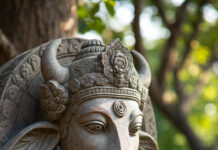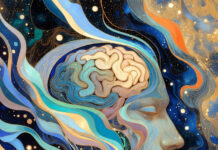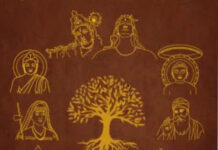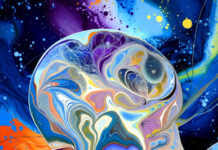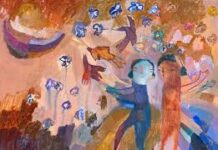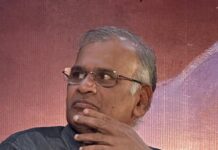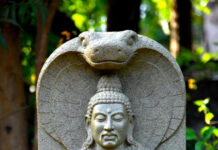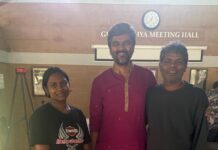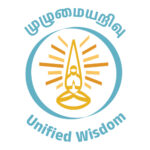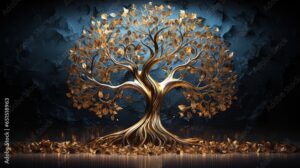
We need to be clear with four fundamental concepts in order to understand Indian thought. We can use them as an aerial rope as we proceed to make our way through the jungles of the Indian philosophical traditions.
Liberation
All schools of Indian thought begin with an investigation of the question – what is the use of this school of thought? Why should one learn these ideas, why should one lead one’s life according to its principles? All the schools of thought first provide an answer to this question before embarking on an exposition of the central idea. The answers they provide can be condensed into a single word – liberation. This concept is explained using various words – mukti, moksham, veedupEru (taking on various shades of meaning, including freedom, release, relief and attainment -tr). These words denote different subtle ideas in different schools of thought. But all the schools of Indian thought are common in their shared understanding that the ultimate purpose of any knowledge should be liberation.
In order to speak of liberation, we must establish an idea very clearly first. It is that man is always held in bondage. Indian thought starts with the preliminary understanding that man is held in bondage by his own ignorance. Ignorance is suffering. Philosophical knowledge should liberate man from his suffering.
Therefore it is always clear what philosophical thinking should ultimately do for man. It has to find a way to eradicate the suffering caused by ignorance or wrong knowledge. It has no other use. There is no obligation for it to provide man with any immediate worldly gain.
From the time man is born he is entirely in the grip of nature. The Gita says that man is shrouded by ignorance the way a baby is shrouded by the womb. This is a deep metaphor. Man is formed in the womb, but it is only when he is able to break open and emerge that he can be born. Similarly man is formed out of nature. However it this only when he tears apart the ignorance nature confers on him can he be born a man.
Knowledge is necessary for this transformation. Man starts to learn about everything around him. Each bit of knowledge frees him. A man learns the nature of water, that knowledge is one kind of freedom. Once man learns the nature of fire, that is another kind of freedom. The knowledge of electricity frees man a little bit more. There comes a time when he naturally starts having questions about his own nature. He starts to ask who he really is.
This question comes to him like a bolt in three ways. 1. Where do I come from? Where do I go after my death? 2. How do I know this world, and is my knowledge true? 3. What is my place in this vast universe? What is the meaning of my life?
If he does not have answers to these questions then he is no longer able to face life. At every moment he is filled with suffering and depression. The philosophical term for this suffering is ‘dukkha’. Philosophy should provide the answers for his questions and liberate him from his suffering.
One can go so far as to say that science, philosophy as well as the many branches of knowledge available today try to answer each of the questions listed above in their own ways.
Each Indian philosophy has a different interpretation for what it means to be liberated. What does the atheistic philosophy of Sankhya say about liberation? It holds that this universe was created out of primordial nature, an unmanifest material unity. The three qualities of stasis (harmony and contentment, sattva), antistasis (darkness and chaos, tamas) and dynamics (energy and passion, rajas) were perfectly balanced in it. When that balance was disturbed, that material unity became differentiated into many. That is what we see around us as the universe. When we encounter the universe in its many forms, we are not able to understand its real nature. So we suffer. But if we could transcend the three qualities and integrate them within ourselves then we would also be able to understand the nature of the whole universe as but the varied manifestation of one underlying reality. That knowledge destroys our anxieties about the universe and liberates us from our suffering.
What would be a Vedanta practitioner’s answer to this question? A Vedanti would say that what appears as this universe to me is not real at all. What I see is only a projection formed as a result of my basic tendencies. It does not exist. Only the substrate that underlies what I see has real existential basis. Hence the universe does not exist, only the substrate exists.
That substrate can never be known. However I can feel its existence in every little thing around me. That alone exists, that alone is all of this. Only that is I. My consciousness in which this very knowledge arises is also that, so I am consciousness itself. What I perceive as myself, my personality, is simply an illusion that I create for myself out of my ego. All my suffering is because I create such an illusory identity for myself. When I let go of this artificial partition, when I realise that I am nothing but that existential conscious substrate itself, I become whole, and my sufferings cease.
What is the liberation promised by Buddhism? According to Buddhism, the universe is in a constant state of change. I see it in everything around me every day. Therefore I do not see objects. I only see the change in them. There is a basic law to how things change. This law can be formalised in the form of a universal law of change. That is called the mahadhamma. Even I and my thoughts change according to the law of mahadhamma. If I can unite myself with the flow of the mahadhamma, then I have no suffering. I suffer because I refuse to join its great flow, because I try to stand apart.
One can explain these three answers using a simple example. Let us imagine that fish in the ocean knows itself as the fish and its surrounding environment, the ocean. If the fish were to see itself separate from the ocean, then can it ever understand the entirety of the ocean? If the fish realises that every moment of its life is dependent on the great ocean in which it swims, the ocean it can never understand, would that not disturb and frighten the fish very much? However, if the fish realises the ocean is nothing but itself and hundreds of other fishes like itself, that the ocean is one great entity that the fish is no different from, then its anxiety ceases. The fish realizes that it is also the ocean. That is freedom.
From these discussions, we come to an understanding. Here, both the question and the answer are philosophical. They are not relevant to our everyday life. They are not determined by temporal concerns like politics or power struggles. They belong to another realm altogether. Here, the question stems from existential anxiety that man faces when he encounters the universe. He experiences discomfiture about the nature of the universe, the meaning of life and his place in it. The answer seeks to alleviate that.
If we have such questions, then we can engage with philosophy. Otherwise, it is not necessary. Our everyday concerns or politics are not relevant in the enterprise.
Universal essence
What is the essential reality of the universe? Many schools of Indian thought ask this question. We feel the universe around us every day. We sense a certain rhythm and order to it. We may even feel a directive purpose in it. If so, this endless universe could have an essential order and purpose to it. What is that?
The first among the Vedas, the Rigveda, presents us with a very grand picture of the universe. It describes endless space. Countless universes are born and die in that endless space. How were they born? What happened to them? How did they die out?
The Vedas call this essence of the universe ’tat’ – that. It cannot be known, they say. It cannot be explained with words, it is beyond language. That great unknowable is called Brahman. However, we can intuit the existence of that great unknowable in everything we see and sense around us every day. We can use this intuition to conceive of that essence.
That is what Vedanta call Brahman. Buddhism called it Mahadhammam. According to Vedanta, that unknowable one shines forth, reveals itself as this universe. According to Buddhism, that great unknowable is only an operational principle. That law determine all action and change in the universe.
When a firebrand is waved around its tip dances wild in the air. Circles of light appear in the air. But when the motion ceases, the circles also cease. Only light exists. The circles are our own impressions. If the light is the Brahman of Vedanta, the circles are all of creation. A gramophone plate spins fast. We see a rapidly spinning disk and its axis. If the plate is the universe, the motion of the plate spinning on its axis the the Mahadhamma of the Buddhists.
Those who claim that such a centre exists are called the spiritualists. Others who deny its existence called the materialists. Between the two, there have always been much debate and disagreement. There are strong arguments in favour of both schools of thought.
Fate
The idea of fate is present in all the schools of Indian thought. Everything that we experience in this world have their operational principles. They are pre-determined. Similarly there is a principle that underlies all the operations of human life. This principle is commonly called fate or predetermination.
Fate can be described using a simple analogy. There are great anthills in Africa. A single anthill may be thousands of years old. It could be hundreds of feet high. It may have a very delicate, very complicated architecture. However, a single ant lives for only a few days. Its brain is also very small. If so, in whose mind is the blueprint for that great anthill located?
The answer is, the anthill is in the mind of the entire colony. An ant is born. For four or five days, it carries a few grains of sand, places it somewhere. Then it dies. But it is really building an enormous anthill that it can simply not conceive of in its individual imagination. To accomplish this task is its fate.
And so is the life of a man. The actions that a man will do in his life are, at its core, pre-determined. He acts as only a cog in a wheel. He has no way of ever determining the outcome this action. Therefore all that he can do is to perform his work as perfectly as possible. This is the essence of the idea of fate.
Each religion has a different conception of fate. Many schools of the Hindu tradition hold that it is the result (or karma) of one’s actions in previous births that determine one’s fate in the present birth. The Jaina and Buddhist traditions also accept this.
The circle of life
What is the relevance of all this philosophy in our day to day life? The Indian tradition divides all knowledge into two levels. The samanya – transactional and the visesha – special. The samanya knowledge is for everyday transactional life. The visesha knowledge refers to higher philosophical truths that we grasp using our logic and intellect. Everything here is brahman – this is visesha knowledge. But the difference between bitter strychnine fruit and the sweet mango is a samanya knowledge. Both are two sides of the same coin.
The knowledge that we attain in the visesha level should help us in the samanya mode. That is why they were simplified into everyday ethics. As far as Indian thought is concerned, ethics and morality are relevant only in the samanya mode. They do not apply in the visesha mode, the level of philosophical speculation. At this level, only questions speculating about the nature of the universe, the nature of existence, are relevant. It is only when we apply the answers from the visesha level to our everyday, transactional life that ethics and moral codes are created. This is how Buddhism arrives at its prescribed ethics, including non-violence.
Each school of knowledge has certain fine differences in its prescriptions of right ethical and moral behavior. As far as the Indian tradition is concerned righteousness – aram, dharma – does not change. But morality can change with time. Thus, when philosophy meets everyday life, religions are born. Religion transforms philosophy into ethics, rituals and beliefs and brings it to the people.
Our tradition calls the circle of life, samsara. We believe that philosophical knowledge will liberate us from the suffering caused by samsara.
*
The tradition of Indian thought is many thousands of years old. When we approach any school of Indian thought, it is first necessary to understand where it stands with respect to each of the four topics outlined above. It is on this basis that we can define each school, and compare and contrast between them.
[Opening remarks, a discussion on Indian philosophy, Ooty, 27.08.10]
Translated by Suchitra Ramachandran
Related Articles
